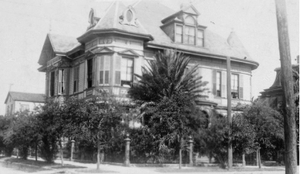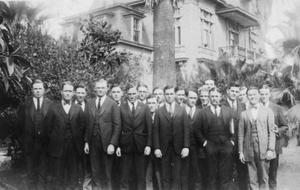As many beautiful, historic homes as Galveston is proud to have dotting the island, some of the
finest from the past are, sadly, lost. One of these was a spacious, three-story Victorian mansion in the east end of the city at 1228 Market. The home, which belonged to the family of Johann “John” Focke, was constructed in 1886.
The few photos that exist of the large clapboard-sided home, which sat on three lots, portray a grand design that included intersecting gabled roofs, dormers, a grand wraparound porch, and an ornately trimmed cameo window on the third floor. One balcony and four galleries, including a grand wraparound porch, provided outdoor living areas for the family. Delicately wrought
iron finials and cresting topped the roofline.
The home featured two fireplaces in the first floor entertaining rooms, which were often festooned with strands of ivy and other greenery for celebrations. A kitchen, butler’s panty, storeroom, library, dining room, bedrooms, bathrooms, and living area were counted among the exquisite fourteen rooms in the house, and were described as “beautiful and elegant” by visitors.
The design also included four closets, which was quite a luxury for the time period. The home
was also equipped with both gas and electric lighting fixtures.
A separate 18-foot by 44-foot two-story building sat on the north part of the lot behind the main house. The ground floor served as stables, the upper floor comprised the servants’ quarters, and it was topped with its own wooden cistern.
Also noted in insurance papers for the property were a chicken house, and wooden cistern to serve the larger home.
A home of this grand scale obviously belonged to someone of importance in the community.
COTTON WAS KING
John Focke immigrated from his native Oslebhausen (near Bremen), Germany and lived briefly in New York. In the 1850s, he worked in Matamoros, Mexico, for the English firm of De Jersey and Company.
He met fellow German-American Henry Wilkens while in Mexico, with whom he formed Focke & Wilkens. The company conducted a lucrative cotton trade with Confederate quartermasters at the beginning of the Civil War.
During his time in Matamoros, Focke engaged in business with former LaGrange mayor and Galvestonian George Marckmann, a cotton factor and merchant who ran wagon trains to Mexico.
In the summer of 1866, just one year after Focke and Wilkens had moved their cotton business to Galveston, Focke and Marckmann met again aboard a steamer bound for France. A shipboard romance developed between Focke and Marckmann’s daughter, Anna, who was headed on a family vacation through Europe preceding her entry into a Paris school. The pair had previously met in New Orleans and New York.
That part of her education never happened, however, since romance blossomed and eventually led to marriage at the American Embassy in Berlin, Prussia, the following October. The blonde haired, blue-eyed John was 30 years old. Anna, an attractive brunette, was 23.
The newlyweds returned to the United States to make Galveston their home, and eventually had eight children.
In addition to his partnership with Wilkens, Focke was a director in the Texas Guarantee and Trust Company, and the Southern Compress and Manufacturing Company. The businessmen took in another partner, H. C. Lange, in 1882, and the firm’s name changed to Focke, Wilkens & Lange. They branched out into dealing in wholesale groceries, and soon moved from the Produce Building on the Strand to their own building at 2402-2410 Strand.
In 1886, John Focke built the grand home on 1228 Avenue D (Market) for his family that reflected his stature in the community.
GERMAN HOSPITALITY
The Focke family was very involved in the community in both business and social circles, and hundreds of friends and acquaintances enjoyed their beautiful home through the years. The rooms were often filled with parties for Mardi Gras, holidays, charity benefits, engagements, and their children’s weddings and receptions. Special events were even hosted there for the officers of visiting ships from Focke’s home country of Germany.
No detail was overlooked, including wrapping banisters, mantles, and columns with greenery and
hiring the finest musicians such as the St. Cecilia Orchestra.
The ladies of the family hosted garden parties, such as the one in May of 1905 to aid the Hospital Aid Society of John Sealy Hospital. The large lawn, planted with palms, banana trees and blooming plants, was an ideal setting for lawn parties where lemonade was served along with sandwiches, cake and ice cream. Lanterns and crepe were draped from the trees and balconies,
and attendees wore their finest summer whites.
1900 STORM
Two of the Focke daughters spent the summer of 1900 in Hanover, Germany pursuing their education. They learned about the devastating hurricane that September like so many others, through news accounts and telegrams. The first letters they received from their mother assured them that every family member - except for one of their married sisters who lived in Hitchcock - was safe. Luckily, it was later learned that she survived the storm, as well.
Anna Focke is often remembered for her descriptive letters she wrote just after the 1900 Storm. Writing to her daughters, she confirmed some of the horrors witnessed on the Island and alerted them to prepare to return home as soon as passage was arranged, because the family could no longer pay to have them live abroad.

The Focke house was only 14 blocks from the Gulf of Mexico, but it was large and sturdy and had weathered other storms. At the height of the storm, only Mrs. Focke, her son George, and two servants (a maid and a cook) were in the house. Mr. Focke remained at his place of business downtown and was only able to return home the next day.
The lovely home had suffered extensive damage, but was still standing. The roof was practically destroyed, windows blown out, interior plaster had fallen, and most of their furnishings were water-soaked. The chimneys and interior doors were damaged, as well. They moved into their office building, but almost immediately its first floor caved in and ruined most of the salvaged belongings.
They returned home where the library, and one bedroom were the only dry rooms. Mrs. Focke and George slept in son John’s intact room, and Mr. Focke slept in a corner of his own damaged bedroom.
By early November, however, all the repairs except for replacement of the plaster had been accomplished.
END OF AN ERA
Focke, Wilkins & Lange flourished until Focke’s death from Bright’s disease in 1907, at the age of 71. He and Wilkens had been partners for 45 years. The firm name survived until 1917, when it was shortened to Wilkens & Lange.
As was customary at the time, his funeral service was held in his home in the front parlor. He is buried in Galveston’s Trinity Episcopal Cemetery.
His was the first of three family funerals held in the mansion. The Focke’s son George was fatally injured in a fall from a horse on the Big Canyon Ranch in Sanderson in 1909. Following his death, his mother brought him home to Galveston to be buried.

Anna passed away in 1920, at the age of 77, and was buried alongside her husband and son.
FRATERNITY YEARS
Members of the family remained in the house until 1923, when John W. Focke sold the home and “all but a small strip of land” to trustees of the Alpha Mu Pi Omega medical fraternity for $15,000.
In 1937, AMPO, which had been the first medical fraternity on the University of Texas Medical Branch campus, ceased to exist, and the house was sold to the largest medical fraternity, Phi Beta Pi, for just over $5,000.
The alumni of that fraternity paid to thoroughly remodel the Focke home inside and out, but kept the exquisite Victorian details. With 70 active members, the house was once again filled with social activities and celebrations.
A total of 38 of the members lived in the home, and 45 ate meals at the house three times a day every day. The dining room sat between a kitchen and an impressive reception room, where members gathered to play dominoes, bridge, and checkers.
A cook, maid, and two porters were employed full time, and additional help was hired as needed to keep the large house running.
A long hall connected a billiards room with a second reception room in the southwest corner of the house. The fraternity chapter meeting room, lined with class photos, occupied the third floor.
The group held one formal dance each year and entertained informally almost every month.
It’s interesting to note that the only remaining chapter of Phi Beta Pi in the nation is on the Galveston campus.
When the group decided to sell the home in the 1950s, the condition was deteriorated to the point that no interested buyers could be found during a two-year search. In February 1956, newspaper ads announced the sale of remaining furnishings, and in April the home was demolished.
All that remains of the once elegant residence are family stories and memories of Galvestonians old enough to remember the grand home.